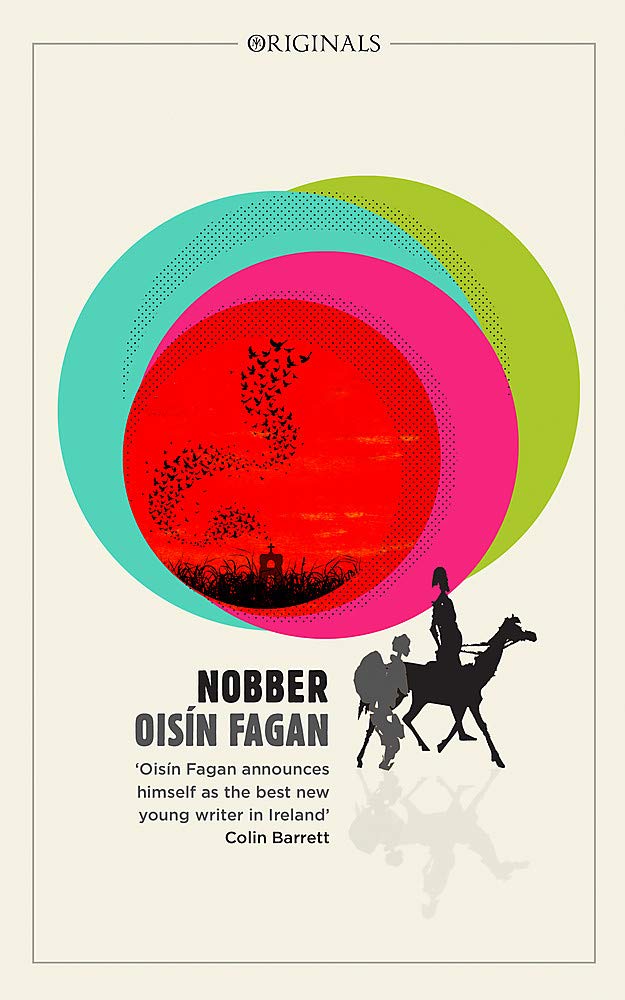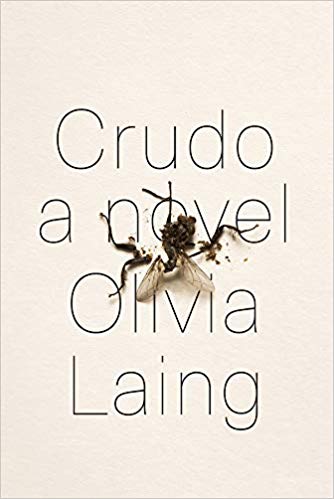
(John Murray Originals, 2019)
REVIEW BY SHASTRI AKELLA
—
Nobber has an exceptional opening act, one that removes the conditional out of John Gardner’s oft-quoted idea that all great novels begin either with a stranger arriving in town or a character taking a journey. Oisín Fagan’s novel begins with four characters taking a journey, and then the novel shifts point-of-view: these strangers arrive in the town of Nobber, and their arrival is shown through the eyes of the locals. The novel, at first, shifts perspectives from one chapter to the next, bringing Faulkner’s As I Lay Dying to mind, but as the story progresses, the point-of-view starts to shift within chapters, and at an increasingly dizzying pace, leaving readers with the distinct impression that Nobber is the schizophrenic monster-protagonist and we are stuck inside its head, an experience that anyone familiar with a small town and its incestuous intimacies and flawed loyalties will recognize. It is a setting that in Stephen King’s works is often the source of horror and that, in Fagan’s hands, also has a distinctly Dickensian feel, the claustrophobia of the setting accentuated by the epic scale of the narrative that plays out in such a tight space.
The novel is set during Ireland’s black plague, but its temporal distance does not make its characters feel any less familiar. de Flunkl and his men are on the move in pursuit of real estate in a time of economic slump; their goal, to buy property on the cheap so they can sell it for a higher value once the plague has ended, holds a strong presence in literature set during the Depression. The men have two encounters as they are about to enter Nobber: the first one is with a band of Gaels, a people who have been displaced from their lands and into the wilderness, and who are now perceived to be ‘savages’. The tension of the prolonged dialogue between the men and Gaels, made possible with the assistance of a translator, William (who is a part of de Flunkl’s retinue), hints at social tensions that, in the present political moment, feel close to home (no matter where, geographically speaking, home is). The second encounter, which I will focus on, brings up a striking instance of the animal dysmorphia that runs like a thematic thread throughout the novel. On the outskirts of Nobber, the men see “a cruciform of wood…on it, thickly laid like a skeleton’s musculature, are reams of dead crows, and they give the form a certain plumpness and lifelikeness from a distance.” The crows, which at first de Flunkl assumes are dead, are “nailed into the wood”. As Harold, another member of the itinerant group, persuades de Flunkl to retreat, warning him that such a ghastly sight can bring no good tidings their way, one of the birds starts to flap its wings, and several others follow suite, and a horrified de Flunkl realizes that they are, in fact, alive. The cross, they notice, is topped with a peasant’s cap, a detail which becomes a lens to read the broader narrative implications of the sight.
Throughout the novel, Fagan uses animal dysmorphia alongside a disintegrating human psyche to place the human and the non-human on a level plane. The conjunction becomes a powerful device to show how the victimized responds to a loss of control by distorting the reality of someone less powerful then themselves. A character who enters Nobber with two lambs, two calves, and a badger (all of which are stolen or captured), reflects: “if animals are jumbled up too greatly in species, and confined too closely, disastrous things happen…Beasts, who should emerge into the synechdocal perfection of predator and prey, too closely combined begin to act in an erratic and unpredictable manner. Both of the lambs think one of the calves is its mother. One of the calves thinks [he] is its mother, and the badger, who should prey on the lambs, instead wishes to prey on him.” Earlier in the novel, a local of Nobber is approached by four men who are naked and who have “sheep skulls tied to their heads.” Mary, a Gael who is kidnapped by Colca (another local of Nobber, and one of the more notorious characters in the novel), kills a horse, but this act of cruelty too is inseparable from human depravity. Colca, as readers find out, practices bestiality, and the novel hints at him having sexual contact with the horse. Rather than the plague taking a toll on both man and animal, it messes with the minds of the humans who then act against the animals.
The action of the novel, once de Flunkl and his men arrive in Nobber, takes places almost exclusively inside the houses of locals. Behind each locked door are an unlikely pair or group of people who parry for power. At times the dead and the dying are trapped in the same space, and the corporeal effects of the plague create for tremendous moments of body horror like the following one:
“Dervorgilla’s arms, held above her head, are shivering with such force that they are almost a blur. Amidst the matted hair of her armpits are swollen protuberances with smooth surfaces. The swellings are hairless, yellow and thick, one under each armpit, like hidden apples growing out of her. One of them is covered in stale pus that has erupted at some former point. Around each buboe is a purple circular bruise, perfect as the concentric ripple of water…[And] Tedbalt[‘s] putrid carcass is decomposing, sunken beneath his work clothes. Steam rises off him, blending the little light above him into a wavy mirage, and his face is covered in a blanket of sleeping flies.”
In the final act the action shifts to the town center, bringing all of its residents together. Colca becomes the focal point of everyone’s anger. Throughout the novel, he enforces a curfew on the people of Nobber to keep the plague from spreading. He kidnaps a Gael and hold her hostage as his ‘wife’, and he has an abnormal relationship with animals. Yet, the conversation he has with his mother and her grief as she watches the plight her son is subjected to makes us wonder if the vigilante form of justice is deserved. And in the process dehumanizing Colca, the people of Nobber dehumanize each other.
Christopher Higgs (2017) poses the rhetorical question of ‘what does it mean to be human?’ and then responds to it to the following effect: “one is not born a human, one becomes human,” for to be human is “not a natural fact. Instead, it is the result of a certain history, a certain civilization, which has resulted in [his or] her current status” (8). Being human, Higgs notes, is a social construct. He adds that “we must not be fooled into believing a human is a human and a monster is a monster outside of or isolated from social and historical contexts” (9). If the notion of what it means to be human has historically been a patriarchal construction—the patriarchy placing a boundary around what it means to be a human civilization and deciding on the laws of governance that decide who qualifies and who disqualifies—then dehumanization, as Peter Grosvenor (2014) states, is the “psychological capacity to relegate people to the status of non-human animals, and to deprive them of the protection normally accorded to fellow humans by moral codes” (154). Thus, “to become a human,” Higgs states, “one must participate in a system of belonging…one becomes human by sacrificing autonomy in favor of participation…those who are human make this agreement. To break this agreement is to become Other” (31). As a socio-cultural construct humanity is, Higgs notes, an act of membership. The shifting points-of-view in Nobber show how each character is, in turn, dehumanizes/is dehumanized. In the face of the plague, the system of belonging that the locals of Nobber participated in, and that the Gaels were kept out of, has fallen apart, leaving the former with no familiar system to work within, thus reducing them all, in status and behavior, to non-human animals. Their treatment of animals is reflective of their own psychological and social condition.
The novel is highly relevant to our current sociopolitical and environmental reality: where on the one hand, the surge of right-wing regimes has narrowed and tightened the boundaries of the systems of belonging that keep some people in and everyone else out, environmental collapse, on the other hand, is on the brink of erasing all such known systems, creating new ways of life—a hitherto unknown chaos—where those who dehumanize the Other also dehumanize each other because the system that once held them together has fallen apart. Indeed, the locals in Nobber dehumanized the Gales until the plague hit them and then they started to dehumanize each other. One need look no further than the fact that Syrian refugee crisis that began because of an environmental disaster created mass migration into Europe, and the attitudes towards these migrations in turn caused a split between the U.K. and the rest of Europe, precipitating the coming about of Brexit.
I began with a famous literary tenet, and I would like to end with one. Ursula K. Le Guin once remarked that all fantastic narratives ultimately address the ills that ail our present social reality, ills that have become background white noise to us and that, therefore, when exaggerated and placed in strange new spaces, far removed from our reality, startle us into paying attention. That, I think, is where the genius of Fagan’s novel lies. In making us pay attention to the black Plague in the 1300s and showing us how some complex, well-wrought characters react to it, it makes us pay closer attention to our own disintegrating reality, to those around us, and ultimately to ourselves. It interrogates the systems of belonging we participate in and it creates a powerful experience of empathy for our future selves who might no longer have access to those systems and who will, as a result, be Othered. And seeing our future Othered selves might exactly be what we need to empathize with the Other in the here and the now. Nobber is an ode to precarity, one that I think will live beyond its generation, serving as both an instructive allegory and a highly readable work of fiction.
—
Shastri Akella earned his MFA in fiction at the University of Massachusetts (Amherst) where he is a doctoral candidate in Comparative Literature. His story won the Bridging the Gap fiction contest at the Slice Writers’ Conference in 2018. His works appears in Guernica, Electric Literature, The Common, Rumpus, World Literature Today, LA Review of Books, Danse Macabre, and European Stages, among other places. He is currently seeking agents for his novel, The Elephant Songs, queer novel set in 1980s India with an an interracial love story at its core.
![[PANK]](https://pankmagazine.com/wp-content/themes/pank/assets/images/pank-logo-large.png)


